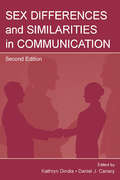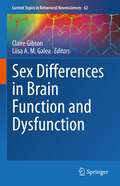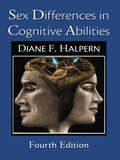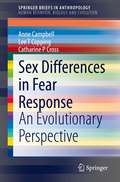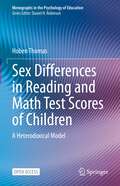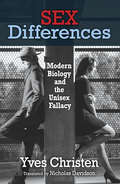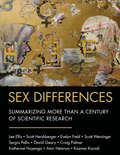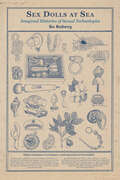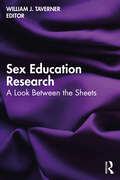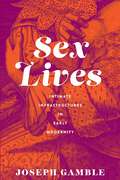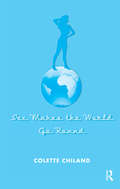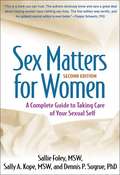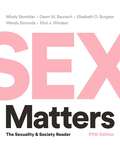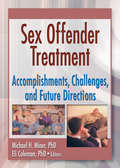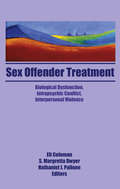- Table View
- List View
Sex Differences and Similarities in Communication (Routledge Communication Series)
by Daniel J. Canary Kathryn DindiaSex Differences and Similarities in Communication offers a thorough exploration of sex differences in how men and women communicate, set within the context of sex similarities, offering a balanced examination of the topic. The contents of this distinctive volume frame the conversation regarding the extent to which sex differences are found in social behavior, and emphasize different theoretical perspectives on the topic. Chapter contributors examine how sex differences and similarities can be seen in various verbal and nonverbal communicative behaviors across contexts, and focus on communication behavior in romantic relationships. The work included here represents recent research on the topic across various disciplines, including communication, social psychology, sociology, linguistics, and organizational behavior, by scholars well-known for their work in this area. In this second edition, some chapters present new perspectives on sex/gender and communication; others present substantially revised versions of earlier chapters. All chapters have a stronger theoretical orientation and are based on a wider range of empirical data than those in the first edition. Readers in communication, social psychology, relationships, and related fields will find much of interest in this second edition. The volume will serve as a text for students in advanced coursework as well as a reference for practitioners interested in research-based conclusions regarding sex differences in communicative behavior.
Sex Differences in Brain Function and Dysfunction (Current Topics in Behavioral Neurosciences #62)
by Claire Gibson Liisa A. M. GaleaDoes sex matter when it comes to brain function? This volume attempts to answer this very important question which is of relevance to the disciplines of psychology, neuroscience, psychiatry and neurology. Understanding how brain function and resultant behaviors may differ between the sexes impacts upon our knowledge of the pathology and development of treatments for various neurological and psychiatric disorders, particularly those that show significant sex differences in either prevalence and/or manifestation of symptoms. This volume covers three main themes of research into sex differences in basic neurobiology, psychology, preclinical research and clinical research. It begins by exploring our understanding of sex and gender in relation to both animal and human behaviors and discusses the relevance, and importance, of considering sex and gender when conducting research into brain function and behaviors. The second theme focuses on how sex and gender influence mental health and considers the impact of our immune system and the changes that occur with ageing. Finally, the third aspect focuses on examples of neurological disorder which show sex differences in terms of their aetiology and/or symptomology and considers the relevance in the development of treatment for these disorders including dementia, stroke and multiple sclerosis. This volume is of considerable interest to mental health and neurology professionals, including psychiatrists, neurologists, nurses, allied health clinicians and pharmacists. It is also helpful and important for preclinical researchers working in neuroscience, psychopharmacology and reproductive endocrinology.
Sex Differences in Cognitive Abilities (4th Edition): 4th Edition
by Diane F. HalpernThe fourth edition of Sex Differences in Cognitive Abilities critically examines the breadth of research on this complex and controversial topic, with the principal aim of helping the reader to understand where sex differences are found – and where they are not. Since the publication of the third edition, there have been many exciting and illuminating developments in our understanding of cognitive sex differences. Modern neuroscience has transformed our understanding of the mind and behavior in general, but particularly the way we think about cognitive sex differences. But neuroscience is still in its infancy and has often been misused to justify sex role stereotypes. There has also been the publication of many exaggerated and unreplicated claims regarding cognitive sex differences. Consequently, throughout the book there is recognition of the critical importance of good research; an amiable skepticism of the nature and strength of evidence behind any claim of sex difference; an appreciation of the complexity of the questions about cognitive sex differences; and the ability to see multiple sides of an issues, while also realizing that some claims are well-reasoned and supported by data and others are politicized pseudoscience. The author endeavors to present and interpret all the relevant data fairly, and in the process reveals how there are strong data for many different views. The book explores sex differences from many angles and in many settings, including the effect of different abilities and levels of education on sex differences, pre-existing beliefs or stereotypes, culture, and hormones. Sex differences in the brain are explored along with the stern caveat to "mind the gap" between brain structures and behaviors. Readers should come away with a new understanding of the way nature and nurture work together to make us unique individuals while also creating similarities and differences that are often (but not always) tied to our being female and male. Sex Differences in Cognitive Abilities, Fourth Edition, can be used as a textbook or reference in a range of courses and will inspire the next generation of researchers. Halpern engages readers in the big societal questions that are inherent in the controversial topic of whether, when , and how much males and females differ psychologically. It should be required reading for parents, teachers, and policy makers who want to know about the ways in which males and females are different and similar.
Sex Differences in Depression
by Susan Nolen-HoeksemaHow can we account for the fact that women are twice as likely as men to experience protracted sadness, apathy, low self-esteem and other symptoms of depression?
Sex Differences in Fear Response: An Evolutionary Perspective (SpringerBriefs in Anthropology)
by Anne Campbell Lee T Copping Catharine P CrossThis book reviews the evolutionary forces behind sex differences in fear responses and, crucially, delves into the mechanisms through which sexual selection might have driven sex differences in connection with fear. Fear is an evolved mechanism that helps us stay alive, but is also an emotion experienced more intensely, more frequently, and longer in women than in men. This book therefore asks the following question: Why might evolution have made women more motivated than men to avoid danger? It provides an overview of the brain areas underpinning the experience of fear and evaluates the evidence that these areas manifest sex-specific differences in their structure and function. Given its scope, the book will be essential reading for anyone interested in an evolutionary perspective on psychological sex differences.
Sex Differences in Reading and Math Test Scores of Children: A Heterodoxical Model (Monographs in the Psychology of Education)
by Hoben ThomasThis open access book examines why reading and math test scores for boys and girls have differed since the origins of testing in the United States. It details the pattern of differences that have remained largely unchanged for more than 100 years in the United States and worldwide. The book explores why boys have modestly larger math test score means than girls, and why girls have far larger reading test score means than boys. Boys have larger test score variances for both tasks. The only data of focus—and thus the only data to be explained—are boys’ and girls’ test score sample means and variances. In addition, the book provides the only coherent theory of gender differences explaining math and reading test score means and variances obtained in observational settings. It develops the simple genetical idea framed within a finite probability mixture model; it provides parameter estimates and displays numerous estimated probability distributions associated with the selected accessible studies chosen for analysis; and it extends the theory and provides explanations for never understood puzzling features of test score data. The book requires no auxiliary sources, although some understanding of random variables and probability theory is required to follow the formalization. It contains all technical details, including the estimation procedure and an R code implementation. Key areas of coverage include: · Extensive literature summary from a unique data inequalities perspective. · Perspective that challenges existing viewpoints on sex differences, falsifying conventional perspectives. · Illustrates probability modeling of psychological data. · Illustrates the failure of conventional statistics to explain data and the need for modeling data. Sex Differences in Reading and Math Test Scores of Children is an invaluable resource for researchers, professors, and graduate students in educational psychology, teaching and teacher education, literacy / language teaching and learning, mathematics education, curriculum studies, developmental psychology, statistics, and all interrelated disciplines.
Sex Differences in Social Behavior: A Social-role interpretation (Distinguished Lecture Series #Vol. 1985)
by Alice H. EaglyIn presenting an innovative theory of sex differences in the social context, this volume applies social-role theory and meta-analytic techniques to research in aggression, social influence, helping, nonverbal, and group behavior. Eagly's findings show that gender stereotypic behavior results from different male and female role expectations, and that the disparity between these gender stereotypes and actual sex differences is not as great as is often believed.
Sex Differences: Modern Biology and the Unisex Fallacy (Research And Perspectives In Endocrine Interactions Ser.)
by Yves Christen Nicholas DavidsonFew people realize how much science can tell us about the differences between men and women. Yves Christen, provided the first comprehensive overview of research in this area when this classic book was first published in the1990s. He goes beyond simplistic biology is destiny arguments and constructs a convincing case for linking social and biological approaches in order to understand complex differences in behavior.Biologists agree that the sexes differ in brain and body structure. Christen links these differences in cerebral anatomy to differences in behavior and intellect. Taking his readers on a journey through psychology, endocrinology, demography, and many other fields, Christen shows that the biological and the social are not antagonistic. To the contrary, social factors tend to exaggerate the biological rather than neutralize it.This controversial work, Sex Differences, takes on traditional feminism for its refusal to confront the evidence on biologically determined sex differences. Christen argues for a feminism that sees traits common to women in a positive light, in the tradition of such early feminists as Clemence Royer and Margaret Sanger, as well as more contemporary feminist sociobiologists like Sarah Hrdy. We deny sex differences only at the price of scientific truth and our own self-respect.
Sex Differences: Summarizing More than a Century of Scientific Research
by Sergio Pellis David Geary Lee Ellis Amir Hetsroni Scott Hershberger Evelyn Field Scott Wersinger Craig Palmer Katherine Hoyenga Kazmer KaradiThis volume is the first to aim at summarizing all of the scientific literature published so far regarding male-female differences and similarities, not only in behavior, but also in basic biology, physiology, health, perceptions, emotions, and attitudes. Results from over 18,000 studies have been condensed into more than 1,900 tables, with each table pertaining to a specific possible sex difference. Even research pertaining to how men and women are perceived (stereotyped) as being different is covered. Throughout this book's eleven years in preparation, no exclusions were made in terms of subject areas, cultures, time periods, or even species. The book is accompanied by downloadable resources containing all 18,000+ references cited in the book.Sex Differences is a monumental resource for any researcher, student, or professional who requires an assessment of the weight of evidence that currently exists regarding any sex difference of interest. It is also suitable as a text in graduate courses pertaining to gender or human sexuality.
Sex Dolls at Sea: Imagined Histories of Sexual Technologies (Media Origins)
by Bo RubergInvestigating and reimagining the origin story of the sex doll through the tale of the sailor&’s dames de voyage.The sex doll and its high-tech counterpart the sex robot have gone mainstream, as both the object of consumer desire and the subject of academic study. But sex dolls, and sexual technology in general, are nothing new. Sex dolls have been around for centuries. In Sex Dolls at Sea, Bo Ruberg explores the origin story of the sex doll, investigating its cultural implications and considering who has been marginalized and who has been privileged in the narrative. Ruberg examines the generally accepted story that the first sex dolls were dames de voyage, rudimentary figures made of cloth and leather scraps by European sailors on long, lonely ocean voyages in centuries past. In search of supporting evidence for the lonesome sailor sex doll theory, Ruberg uncovers the real history of the sex doll. The earliest commercial sex dolls were not the dames de voyage but the femmes en caoutchouc: &“women&” made of inflatable vulcanized rubber, beginning in the late nineteenth century. Interrogating the sailor sex doll origin story, Ruberg finds beneath the surface a web of issues relating to gender, sexuality, race, and colonialism. What has been lost in the history of the sex doll and other sex tech, Ruberg tells us, are the stories of the sex workers, women, queer people, and people of color whose lives have been bound up with these technologies.
Sex Ed for Grown-Ups: How to Talk to Children and Young People about Sex and Relationships
by Jonny HuntWhen it comes to talking to children and young people about sex and relationships, it is difficult to know what to say. How do you answer their questions? How much is too much? And what is age appropriate? Sex Ed for Grown-Ups is an open and honest guide that empowers adults to talk to young people about all things sex and relationships. Written by an independent relationships and sex education consultant, this light-hearted and accessible book encourages grown-ups to think and talk about the topics that scare them the most: from body parts, gender, puberty and first-time sex, to pornography, sexting and knowing what to do when things go wrong. Full of hints, tips and first-hand stories, it is a fun, compassionate and engaging exploration of relationships and sex, which will help adults to fully support young people as they develop a healthy view of both sex and themselves. Sex Ed for Grown-Ups is essential reading for parents, teachers, youth workers, social workers and any adult who wants to have well-informed and positive conversations with the children and young people in their lives.
Sex Education Research: A Look Between the Sheets
by William J. TavernerCurated by the chief editor of the American Journal of Sexuality Education, this book presents engaging and accessible chapters that capture current and essential research findings from leaders in the sexuality education field. William J. Taverner brings together an impressive array of contributors to help sexuality professionals remain up-to-date on the most relevant issues in sex education today. Covering a spectrum of hot sexuality education topics, including abstinence, gender, innovative programs, pleasure, the politics of sexuality education, porn literacy, sexual orientation, and more, each chapter describes key findings on a particular topic, their significance, their practical application, and how these new developments have arrived. The book includes chapters that address individuals across all age ranges, from children to older adults, as well as sexuality education and training programs for specialized professions, such as nurses and school-based health occupations. Practical and clear, this book identifies priorities and trends in the field, addresses marginalized audiences and overlooked topics, and hopes to encourage important discussions to come. Sex Education Research: A Look Between the Sheets provides a wide range of occupations and academic disciplines with a foundation of research essential to their work, such as public health professionals and students of human sexuality, gender studies, biology, psychology, sociology, as well as community educators, school nurses and health teachers, and administrative leaders affiliated with sexuality education programs at community-based organizations.
Sex In the Heartland
by Beth BaileySex in the Heartland is the story of the sexual revolution in a small university town in the quintessential heartland state of Kansas. Bypassing the oft-told tales of radicals and revolutionaries on either coast, Beth Bailey argues that the revolution was forged in towns and cities alike, as "ordinary" people struggled over the boundaries of public and private sexual behavior in postwar America.
Sex Is a Spectrum: The Biological Limits of the Binary
by Agustín FuentesWhy human biology is far more expansive than the simple categories of female and maleBeing human entails an astonishingly complex interplay of biology and culture, and while there are important differences between women and men, there is a lot more variation and overlap than we may realize. Sex Is a Spectrum offers a bold new paradigm for understanding the biology of sex, drawing on the latest science to explain why the binary view of the sexes is fundamentally flawed—and why having XX or XY chromosomes isn&’t as conclusive as some would have us believe.In this lively and provocative book, leading biological anthropologist Agustín Fuentes begins by tracing the origin and evolution of sex, describing the many ways in the animal kingdom of being female, male, or both. Turning to humans, he presents compelling evidence from the fossil and archaeological record that attests to the diversity of our ancestors&’ sexual bonds, gender roles, and family and community structures, and shows how the same holds true in the lived experiences of people today. Fuentes tackles hot-button debates around sports and medicine, explaining why we can acknowledge that females and males are not the same while also embracing a biocultural reality where none of us fits neatly into only one of two categories.Bringing clarity and reason to a contentious issue, Sex Is a Spectrum shares a scientist&’s perspective on why a binary view of sex and gender is not only misguided but harmful, and why there are multitudes of ways of being human.
Sex Lives: Intimate Infrastructures in Early Modernity
by Joseph GambleIn Sex Lives, Joseph Gamble draws from literature, art, and personal testimonies from sixteenth- and seventeenth-century Europe to uncover how early moderns learned to have sex. In the early modern period, Gamble contends, everyone from pornographers to Shakespeare recognized that sex requires knowledge of both logistics (how to do it) and affect (how to feel about it). And knowledge, of course, takes practice.Gamble turns to a wide range of early modern texts and images from England, France, and Italy, ranging from personal accounts to closet dramas to visual art in order to excavate and analyze a variety of sexual practices in early modernity. Using an intersectional, phenomenological approach to bring historical light to the quotidian sexual experiences of early modern subjects, the book develops the critical concept of the “sex life”—a colloquialism that opens up methodological avenues for understanding daily lived experience in granular detail, both in the distant past and today. Through this lens, Gamble explores how sex organized and permeated everyday life and experiences of gender and race in early modernity. He shows how affects around sex structure the plays of Shakespeare and his contemporaries, revealing the role of sexual feeling and sexual racism in early modern English drama.Sex Lives reshapes how we understand Renaissance literature, the history of sexuality, and the meaning of sex in both early modern Europe and our own moment.
Sex Made Simple: Clinical Strategies for Sexual issues in Therapy
by Barry McCarthyStrategies to move past affairs, sexual trauma, variant arousal, Framework for counseling gay individuals and couples, Treating sexual dysfunction, Psycho sexual skill exercises, Case Studies, Psycho bio social model for assessment, treatment, and relapse prevention.
Sex Makes the World Go Round
by Colette ChilandIt is well known that Freud laid great emphasis on sexual matters. In the years that followed, a distinction was drawn between sex and gender, and the idea of gender identity was introduced. Human beings do not spend every minute of their lives copulating, but at every minute of their lives their gender identity is present. Sex Makes the World Go Round implies that sex is everywhere, provided that we take into account both sexuality and gender identity. This book continues to develop the author's work concerning sexuality and gender identity. There are two main themes which run through the whole of this book. The first is the distinction, established by Freud and based on clinical data, between the two currents of sexuality: tenderness and sensuality. The other is that women have always been treated as inferior beings. They have always lost out whenever sexual wanderings have been uppermost.
Sex Matters for Women, Second Edition
by Sally A. Kope Sallie FoleySex is talked about more openly today than ever before, but if you still struggle with sexual myths, self-doubt, and "embarrassing" questions, you're in good company. Now in a fully updated second edition, this trusted guide has already helped many thousands of women understand how their bodies work and take charge of their sexuality. The authors are experienced therapists who interweave candid reflections from diverse women with current, science-based information, exercises, and advice. You'll find answers to everything from how to have more satisfying sex to questions about body image, anatomy, hormones, relationships, sexual orientation, sexually transmitted infections, and trauma. Sexuality is a lifelong journey--this book gives you a roadmap for self-discovery and growth.
Sex Matters: The Sexuality and Society Reader
by Wendy Simonds Mindy Stombler Elroi J. Windsor Elisabeth O. BurgessA sex-positive reader that presents sex as a social issue. This popular reader has a strong sociological focus, highlighting the ways that social institutions―and the individuals within them―shape our understanding of sexuality and influence our behaviors, attitudes, and identities. The readings, 50 percent of which are new to the Fifth Edition, cover a diverse range of sexual experiences, including new pieces on asexuality, online porn, and PrEP for HIV prevention. The editors mix qualitative and quantitative empirical pieces, sexual narratives, and articles from the popular press.
Sex Now, Talk Later
by Estela V. WelldonSex matters. It is a crucial part of whom we are and what to do. So why do we police what is 'normal' and what is 'bizarre'? As the author argues in this insightful book, whenever we disapprove of others or ourselves in this way, we close our eyes to a deeper understanding of human nature. As a psychiatrist, she has also worked inside prisons with sex offenders, so she is familiar with the extremes of 'oddity'. Here, she uses a psychoanalytic framework with humour, insight and clarity to explore why we disapprove, and what we lose when we do. She presents us with a series of interwoven vignettes, drawn from clinical work and life experiences, which have led her to these conclusions. The author argues in this book that as human beings we have a responsibility to develop a much more enquiring and open mind, and to feel privileged rather than disgusted when we have access to primitive fantasies that shine light into the dark corners of minds not considered 'normal'.
Sex Offender Treatment
by Leigh Harkins Tanya Garrett Daniel T. WilcoxSex Offender Treatment is an innovative case study-based guide to the treatment of sexual offenders, offering direct access to the insights and experience of experts in the field. The book describes case formulations, assessment processes, and treatment undertaken with specific sexual offender types.Takes an innovative case study approach to sexual offender assessment and treatment, sharing practical insights and real-world experience in a challenging fieldCoverage is organized by key offender populations and includes bipolar offenders, child sexual abusers, Internet offenders, psychopathic offenders, personality disordered offenders and female offendersThis distinctive approach aids trainee and novice workers to recognise key treatment issues, and plan and implement courses of therapeutic engagement and intervention to improve offender self-controlContributors include Bill Marshall, Leam Craig, Phil Rich, Bill Lindsay and Tony Ward
Sex Offender Treatment: Accomplishments, Challenges and Future Directions
by Edmond J Coleman Michael MinerExamine the major advances in sexual offender treatment over the last decade and promising new concepts in treatment, supervision, and research Sex Offender Treatment: Accomplishments, Challenges, and Future Directions points the way toward humane, dignified, effective treatment regimes for sexual offenders. In addition to providing an essential overview of the current state of sex offender treatment, this book examines vital areas of service provision and research and points to future directions for the field. On the medical/psychological front, this volume explores the importance of recognizing comorbid psychiatric factors in treatment and of exploring central nervous system function's role as a cause of sexually inappropriate behavior. In the legislative/justice arena it illustrates a "Circles of Support" proposal that mobilizes community resources to aid the adjustment of released offenders rather than branding them as dangerous to the community. And in the area of service provision, this book presents a treatment approach for residential programs that is inspired by research on childhood behavioral problems and special education. This book will increase your effectiveness with: a model of multisystemic treatment for juvenile sex offenders a restorative justice approach for reintegrating adult offenders into the community a study of the physical/mental correlates of organic brain dysfunction a case report on the use of a pharmaceutical treatment (leuprolide acetate) for pedophiles
Sex Offender Treatment: Biological Dysfunction, Intrapsychic Conflict, Interpersonal Violence
by Edmond J Coleman Margretta DwyerSex Offender Treatment: Biological Dysfunction, Intrapsychic Conflict, Interpersonal Violence assists sex therapists, counselors, psychiatrists, and psychologists working in sex offender treatment in providing more effective services. You’ll gain timely knowledge of sex offending behavior and treatment approaches that will stimulate your thinking and help you improve your research and treatment methodologies. From Sex Offender Treatment, you’ll acquire valuable insight and a cross-cultural viewpoint as you explore chapters written by international scholars who have set the standards of care for sex offender treatment. Contributors aim to improve the effectiveness of sex offender treatment throughout the world by challenging you to conduct more research that will provide a better understanding of sex offenders and improve treatment approaches. Authors presented their contributions at the Third International Congress on the Treatment of Sex Offenders held in Minneapolis, Minnesota. The book begins with a Standards of Care for the Treatment of Sex Offenders. This guides you in increasing the effectiveness of the treatment you provide to sex offenders. The Standards of Care helps you analyze new data and gain a basis for successful sex offender treatment. Following chapters probe into the nature of interpersonal violence and aggression and a further understanding of pedophilia and exhibitionism. You will begin to more thoroughly understand sex offending behavior as you read about: motives contributing to sexual aggression and the confluence model of sexual aggression the background and clinical characteristics of paraphilic individuals and sex offenders a case study of sex offenders, victims, and their families the “abuse to abuser hypothesis” in regard to pedaphilia assessment, psychosexual profiling, and treatment of exhibitionist behavior the treatment of sex offenders with mental retardation the relationship between sex offender treatment success and learning difficulties incest offender perceptions of treatment as used to generate an explanatory theory of the sexual abuse treatment process.Chapters in Sex Offender Treatment emphasize the importance of good assessment techniques, issues affecting victims and families of sex offenders, why treatment does not work for some sex offenders, medical problems associated with sex offenders, and working with special populations of sex offenders. Counselors, researchers, educators, sex offender treatment personnel, forensic psychologists and psychiatrists, and sex therapists will find Sex Offender Treatment crucial for gaining insight into sex offenders’motives and behaviors. You can then use these perspectives to more effectively interact with sex offenders and to more accurately analyze sex offending behavior.
Sex Offender Treatment: Psychological and Medical Approaches
by Edmond J Coleman Margretta DwyerThis important volume brings together findings in the psychological and medical treatment of sex offenders. It disseminates research from experts around the world in the field of sex offender treatment, making this knowledge available to researchers and clinicians everywhere. Professionals struggling to find effective methods for treating their patients will find Sex Offender Treatment a valuable tool for their daily work.Chapters in Sex Offender Treatment cover a variety of topics. Authors examine such areas as psychodynamic and psychiatric disorders associated with the sex offender, findings on pharmacologic interventions, treatment techniques and the public perception of sex offender treatment, and cautionary notes for those who provide therapy for sex offenders. Within these areas, some specific themes addressed include: types of personality disorders and implications for more effective treatment the effectiveness of antiandrogen treatment and the promising results of other pharmacotherapies techniques for developing insight in incest perpetrators a study of adult male incest offenders’perceptions of the treatment process an adolescent treatment program using a family communication approach hypotheses regarding sexual offenders and men who batter, using psychodynamic and feminist theoryFull of practical strategies and useful information, Sex Offender Treatment is a book professionals will reach for again and again.
Sex Offenders
by Arjan A. Blokland Patrick LussierAn authoritative and in-depth treatment of the latest research into the criminal careers of sex offenders, providing background and investigating the policies used to combat one of society's most intractable public issues. Features chapters based on original research from the most prominent scholars in the field of sex offender and criminal career research Deals with the entire criminal careers of sex offenders from youth to adulthood Illustrates the significance of the criminal career approach for theory, treatment, research, and policy regarding sex offenders Covers a wider breadth of topics than existing texts and uses data from various studies and countries, including the U. S. , Canada, the U. K. , and the Netherlands Features an introductory chapter charting the origins of the criminal career perspective as well as the history of sex offender research, pinpointing the most important research questions and current debates in both fields
